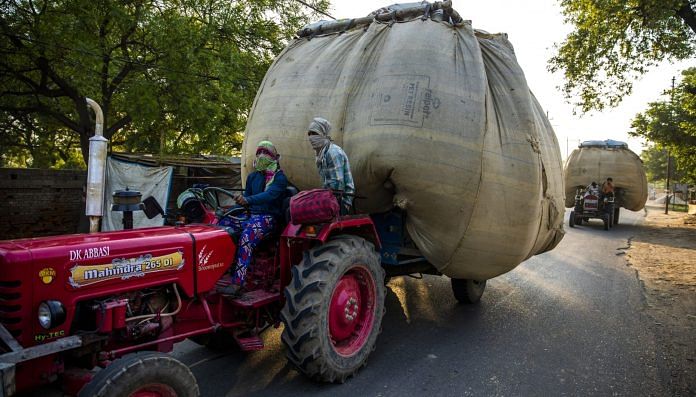New Delhi: India’s economy left cratered by the pandemic is drawing energy from one of its invisible and often-neglected engines: farmers.
Business leaders, policy makers and politicians alike are pinning hopes on the rural sector as bountiful rains have set the stage for another year of record crops. Higher disposable incomes with farmers are expected to boost demand from automobile to cement to gold jewelry.
That contrasts with the urban areas, where companies are still struggling to boost their sales following the pandemic that has hit business activities, hurt demand and caused labor shortage. The adverse impact of the world’s strictest lockdown in March continues to haunt, but the hinterland is holding out hope.
Maruti Suzuki India Ltd. and the local unit of South Korea’s Hyundai Motor Co., the two main players in India’s car market, said October sales were the best-ever for any month. Hero MotoCorp Ltd., the world’s largest maker of motorcycles and scooters, as well as smaller rival Bajaj Auto Ltd., reported record sales, as rural markets provided a cushion against a downturn in cities.
“We have seen a stronger demand from rural areas across categories for our products as compared to last year,” Srinivasu Allaphan, director of sales and marketing at JK Tyre & Industries Ltd. said in an email response. “We expect it to sustain for the next three quarters. Higher sales in rural markets will compensate for the losses in urban and semi-urban towns.”
Rural incomes have stayed strong as production of monsoon-sown food grains is estimated to hit record 144.5 million tons. The government’s move to raise support prices for some crops and boost spending on rural employment programs have also supported incomes of farmers and laborers.
“Despite Covid-19 and the related lockdown, the agricultural activities across the country have almost remained unaffected. This has raised the hope that rural demand could drive the economic recovery,” according to India Ratings and Research Ltd., a unit of Fitch Ratings Ltd.
Unprecedented demand
Some companies reported strong demand for their products and services, such as automobile, cement, steel, tires and jewelry, in rural areas.
Hindustan Unilever Ltd., Asia’s biggest maker of personal care products by market value, said its sales jumped the most since 2011. “We are seeing rural markets as well as smaller towns perform relatively better,” Sanjiv Mehta, chairman and managing director of the company, which sells its products through 8 million outlets in the nation, said on a conference call.
Tractors, passenger cars and light commercial vehicles are seeing a healthy demand as rural buying continues to be strong, according to Mahindra & Mahindra Financial Services Ltd. Farm equipment makers echoed the sentiment. “We continue to witness unprecedented retail demand,” said Hemant Sikka, president at Mahindra & Mahindra Ltd., which also makes tractors.
Even construction activities gathered pace. JSW Steel Ltd.’s retail sales volume more than doubled from a quarter earlier in the July-September period, the company said, while Ajoy Chawla, chief executive officer of the jewelry division of Titan Co., said demand in tier 2 and 3 markets was fueled by weddings that were postponed earlier.
Some farmers preferred to invest in gold. “The post-Covid economic uncertainties will further strengthen demand, as gold has emerged as the safest investment option,” said Ahammed MP, Chairman of Kerala-based Malabar Gold & Diamonds. Tanya Rastogi, director of Lala Jugal Kishore Jewellers, said the rural sector is an “untapped treasure for the jewelry industry.”
Bharat Petroleum, the nation’s second-biggest fuel retailer, said its sales in urban pockets had almost halved, prompting it to quickly focus on the rural and highways segments to contain the market share loss. “We want to capture the rural presence and the Indian rural growth,” said N. Vijayagopal, the company’s finance director.
Also read: Higher interest, processing fee — How banks are making hay amid Covid as customers take a hit
Flash in the pan?
Demand for everything from tractors to jewelry notwithstanding, rural India alone may not be able to underpin a recovery in the economy that’s headed for its worst annual contraction on record, according to top company officials and analysts. With more than eight million reported infections, the South Asian nation is the second-worst-hit by the pandemic after the U.S. and risks remain.
While demand is “good,” and is likely to remain so for the rest of the year due to a good monsoon, it’s difficult to predict sales beyond that, R.C. Bhargava, chairman of automaker Maruti, told reporters. A rush to own private vehicles as people move away from mass transport will be over by January, he said.
Automobile inventories had piled up in anticipation of strong sales during the October-November festive season. Sales were already going through their worst slump even before the virus, and pent up demand during the nationwide lockdown led to increased sales on a lower base.
“I would not really bet on the mass consumer coming back in a hurry because so far I am not seeing any evidence of it,” Rajiv Bajaj, managing director at Bajaj Auto, told CNBC TV-18. “I’m extremely concerned, I’m very anxious.”
Rural demand will perk up somewhat, but will not be able to offset the shortfall in urban demand because the share of agriculture in gross value added of the Indian economy ranged between 14.6% and 17.8% during 2012-13 to 2019-20, according to India Ratings and Research.
Some experts highlighted that India is witnessing an uneven recovery, where upper-income groups are seeing a rapid and strong improvement in their economic conditions, while those with lower incomes are losing ground.
“I must say that while parts of the marketplace are coming back to normal, it still is a reasonable K-shaped recovery,” said Dipak Gupta, joint managing director at Kotak Mahindra Bank Ltd. “Unfortunately, the upper part of the K-curve is still small as compared to the lower part.”-Bloomberg
Also read: Farming GM crops, employment fund — what govt panel has suggested to create 20 cr jobs in 5 yrs






